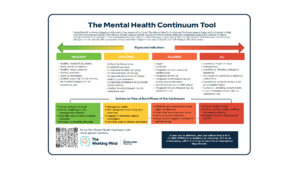Imagine stepping into a smart building—not just a structure, but an interconnected system designed to enhance well-being. The air adjusts for comfort. Lights adapt to your needs. Systems integrate seamlessly, ensuring efficiency, accessibility, and ease of movement.
Now, imagine if organization mental health worked the same way. In today’s world of work, people work in buildings, in the field, and at home. The organization is more than a physical building, it is anywhere a worker is doing work. Imagine if the organization was designed like a smart building – with interconnected systems designed to enhance wellbeing.
Picture this space – in-person, remote or hybrid, where instead of stigma, stress, or uncertainty, you’re in a space where:
- You know you belong
- You have the support you need when challenges arise
- You understand yourself and those around you
- You can do your best work without fear
That’s what Psychological Health and Safety (PHS), Mental Health First Aid (MHFA), and The Working Mind (TWM) help create. Together, they form a connected system that doesn’t just support mental health—it embeds it into the foundation of the organization.
How This System Creates a Supportive, Stigma-Free Workplace
1. PHS is the Smart Building’s Core System (The Backbone of Workplace Mental Health)
A smart building isn’t just walls and windows—it’s a network of interconnected systems that make every other component work better.
That’s exactly what PHS does for workplace mental health. It’s the overarching system that ensures foundational policies, processes, and structures are in place to protect and support the mental well-being of workers. But more than that, it connects and amplifies all other mental health initiatives and business operations.
With the right PHS system:
- Workloads are more manageable, and expectations are clear
- Psychological health and safety is built into leadership practices and culture
- All mental health initiatives are integrated rather than isolated efforts
A standalone policy or training program can only do so much on its own. When connected to a structured PHS system, they work harder, last longer, and have a greater impact—just like how smart buildings make their components more effective.
A strong PHS framework is:
- Broad, in a good way—so it’s inclusive of how work is managed in all areas of the organization
- Integrated and Agnostic—allowing different programs to connect and work together
- Built to evolve—so it adapts to changes in the organization, or in legislation, standards, and other requirements
And most importantly, it’s designed to be user-friendly, ensuring organizations can implement and sustain it.
2. MHFA is the Support System (Providing Help at Any Stage, Without Stigma)
In a smart building, emergency systems—like fire alarms, first-aid stations, and security alerts—aren’t just for crises. There are also wayfinding signs, accessibility features, and automated systems that help people navigate challenges before they escalate.
That’s what MHFA does for mental health. It’s not just about responding in a crisis—it’s about recognizing when someone is struggling and knowing how to help, at any stage.
MHFA-trained individuals are like trusted guides who:
🔹 Recognize early signs of distress
🔹 Know how to step in, listen, and provide reassurance
🔹 Guide people toward the right next steps—without judgment
Because MHFA is embedded into the workplace culture, asking for or offering support becomes second nature. Just as a smart building removes physical barriers, MHFA removes the social barriers that stop people from seeking help.
3. The Working Mind is the Adaptive Technology (Creating a Common Language and Culture of Support)
A smart building doesn’t just react—it adapts to the needs of the people inside.
If a room gets too crowded, ventilation increases. If someone needs specific accommodations, the system adjusts to meet their needs. It continuously learns and evolves to create the best possible environment.
That’s what The Working Mind (TWM) does for workplace mental health.
It’s not just a training program—it’s a mindset shift that helps people recognize and understand their own mental health, communicate about their needs, and build empathy for others.
TWM creates a shared language around mental health, so people feel comfortable discussing their well-being and asking for support
- Improves mental health literacy, so employees can identify changes in themselves and those around them
- Reduces stigma by normalizing conversations about mental well-being
- Fuels a culture shift towards empathy and support, where colleagues understand and respond to each other’s needs
On an individual level, TWM empowers employees to manage their own mental health and show up as their best selves.
On a team level, TWM builds trust, making it easier for people to communicate, collaborate, and support one another. At the leadership level, equipping people leaders with the knowledge, skills, and tools to support their team.
Just like adaptive technology makes a smart building more functional, TWM ensures that workplaces evolve to foster well-being, inclusion, and long-term resilience.
How They Work Together to Build a Culture of Empathy and Support
- PHS is the backbone—the overarching system that connects and strengthens all mental health initiatives.
- MHFA is the support system—ensuring help is always available, at any stage, without fear or judgment.
- TWM is the adaptive technology—helping people recognize their own needs, support others, and create a thriving workplace culture.
The Result: A Workplace Where Mental Health is Built Into the Culture
When PHS, MHFA, and TWM are all in place, mental health isn’t an afterthought—it’s embedded into how the workplace functions.
- Mental health is part of the foundation, not a separate initiative.
- Support is accessible, integrated, and stigma-free.
- Teams communicate, adapt, and create space for each other’s needs.
Just like a smart building removes barriers and optimizes the environment for the people inside, a workplace with strong psychological health and safety measures ensures that employees can do their best work—together.


